Taolin Zhang
A Short Survey on Small Reasoning Models: Training, Inference, Applications and Research Directions
Apr 12, 2025Abstract:Recently, the reasoning capabilities of large reasoning models (LRMs), such as DeepSeek-R1, have seen significant advancements through the slow thinking process. Despite these achievements, the substantial computational demands of LRMs present considerable challenges. In contrast, small reasoning models (SRMs), often distilled from larger ones, offer greater efficiency and can exhibit distinct capabilities and cognitive trajectories compared to LRMs. This work surveys around 170 recently published papers on SRMs for tackling various complex reasoning tasks. We review the current landscape of SRMs and analyze diverse training and inference techniques related to SRMs. Furthermore, we provide a comprehensive review of SRMs for domain-specific applications and discuss possible future research directions. This survey serves as an essential reference for researchers to leverage or develop SRMs for advanced reasoning functionalities with high efficiency.
FastVAR: Linear Visual Autoregressive Modeling via Cached Token Pruning
Mar 30, 2025Abstract:Visual Autoregressive (VAR) modeling has gained popularity for its shift towards next-scale prediction. However, existing VAR paradigms process the entire token map at each scale step, leading to the complexity and runtime scaling dramatically with image resolution. To address this challenge, we propose FastVAR, a post-training acceleration method for efficient resolution scaling with VARs. Our key finding is that the majority of latency arises from the large-scale step where most tokens have already converged. Leveraging this observation, we develop the cached token pruning strategy that only forwards pivotal tokens for scale-specific modeling while using cached tokens from previous scale steps to restore the pruned slots. This significantly reduces the number of forwarded tokens and improves the efficiency at larger resolutions. Experiments show the proposed FastVAR can further speedup FlashAttention-accelerated VAR by 2.7$\times$ with negligible performance drop of <1%. We further extend FastVAR to zero-shot generation of higher resolution images. In particular, FastVAR can generate one 2K image with 15GB memory footprints in 1.5s on a single NVIDIA 3090 GPU. Code is available at https://github.com/csguoh/FastVAR.
Condor: Enhance LLM Alignment with Knowledge-Driven Data Synthesis and Refinement
Jan 21, 2025



Abstract:The quality of Supervised Fine-Tuning (SFT) data plays a critical role in enhancing the conversational capabilities of Large Language Models (LLMs). However, as LLMs become more advanced, the availability of high-quality human-annotated SFT data has become a significant bottleneck, necessitating a greater reliance on synthetic training data. In this work, we introduce Condor, a novel two-stage synthetic data generation framework that incorporates World Knowledge Tree and Self-Reflection Refinement to produce high-quality SFT data at scale. Our experimental results demonstrate that a base model fine-tuned on only 20K Condor-generated samples achieves superior performance compared to counterparts. The additional refinement stage in Condor further enables iterative self-improvement for LLMs at various scales (up to 72B), validating the effectiveness of our approach. Furthermore, our investigation into the scaling for synthetic data in post-training reveals substantial unexplored potential for performance improvements, opening promising avenues for future research.
Lifelong Knowledge Editing for Vision Language Models with Low-Rank Mixture-of-Experts
Nov 23, 2024Abstract:Model editing aims to correct inaccurate knowledge, update outdated information, and incorporate new data into Large Language Models (LLMs) without the need for retraining. This task poses challenges in lifelong scenarios where edits must be continuously applied for real-world applications. While some editors demonstrate strong robustness for lifelong editing in pure LLMs, Vision LLMs (VLLMs), which incorporate an additional vision modality, are not directly adaptable to existing LLM editors. In this paper, we propose LiveEdit, a LIfelong Vision language modEl Edit to bridge the gap between lifelong LLM editing and VLLMs. We begin by training an editing expert generator to independently produce low-rank experts for each editing instance, with the goal of correcting the relevant responses of the VLLM. A hard filtering mechanism is developed to utilize visual semantic knowledge, thereby coarsely eliminating visually irrelevant experts for input queries during the inference stage of the post-edited model. Finally, to integrate visually relevant experts, we introduce a soft routing mechanism based on textual semantic relevance to achieve multi-expert fusion. For evaluation, we establish a benchmark for lifelong VLLM editing. Extensive experiments demonstrate that LiveEdit offers significant advantages in lifelong VLLM editing scenarios. Further experiments validate the rationality and effectiveness of each module design in LiveEdit.
BoostAdapter: Improving Vision-Language Test-Time Adaptation via Regional Bootstrapping
Oct 24, 2024



Abstract:Adaptation of pretrained vision-language models such as CLIP to various downstream tasks have raised great interest in recent researches. Previous works have proposed a variety of test-time adaptation (TTA) methods to achieve strong generalization without any knowledge of the target domain. However, existing training-required TTA approaches like TPT necessitate entropy minimization that involves large computational overhead, while training-free methods like TDA overlook the potential for information mining from the test samples themselves. In this paper, we break down the design of existing popular training-required and training-free TTA methods and bridge the gap between them within our framework. Specifically, we maintain a light-weight key-value memory for feature retrieval from instance-agnostic historical samples and instance-aware boosting samples. The historical samples are filtered from the testing data stream and serve to extract useful information from the target distribution, while the boosting samples are drawn from regional bootstrapping and capture the knowledge of the test sample itself. We theoretically justify the rationality behind our method and empirically verify its effectiveness on both the out-of-distribution and the cross-domain datasets, showcasing its applicability in real-world situations.
BoostAdapter: Improving Test-Time Adaptation via Regional Bootstrapping
Oct 20, 2024



Abstract:Adaptation of pretrained vision-language models such as CLIP to various downstream tasks have raised great interest in recent researches. Previous works have proposed a variety of test-time adaptation (TTA) methods to achieve strong generalization without any knowledge of the target domain. However, existing training-required TTA approaches like TPT necessitate entropy minimization that involves large computational overhead, while training-free methods like TDA overlook the potential for information mining from the test samples themselves. In this paper, we break down the design of existing popular training-required and training-free TTA methods and bridge the gap between them within our framework. Specifically, we maintain a light-weight key-value memory for feature retrieval from instance-agnostic historical samples and instance-aware boosting samples. The historical samples are filtered from the testing data stream and serve to extract useful information from the target distribution, while the boosting samples are drawn from regional bootstrapping and capture the knowledge of the test sample itself. We theoretically justify the rationality behind our method and empirically verify its effectiveness on both the out-of-distribution and the cross-domain datasets, showcasing its applicability in real-world situations.
Block-to-Scene Pre-training for Point Cloud Hybrid-Domain Masked Autoencoders
Oct 13, 2024
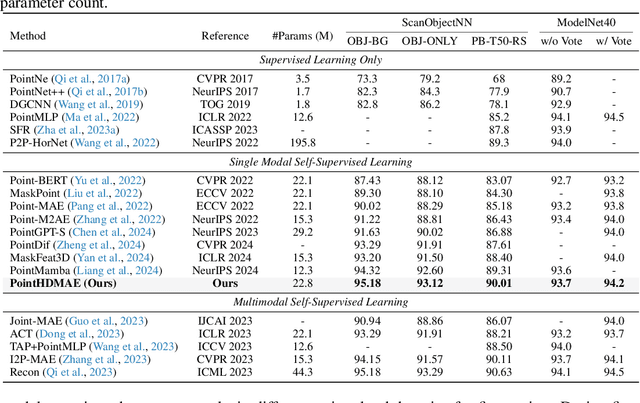
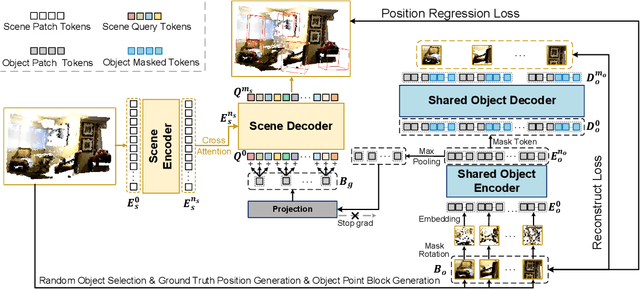
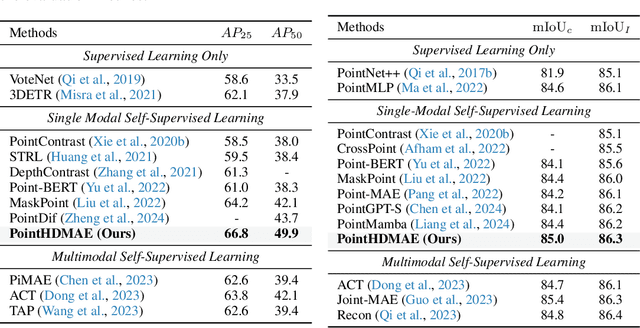
Abstract:Point clouds, as a primary representation of 3D data, can be categorized into scene domain point clouds and object domain point clouds based on the modeled content. Masked autoencoders (MAE) have become the mainstream paradigm in point clouds self-supervised learning. However, existing MAE-based methods are domain-specific, limiting the model's generalization. In this paper, we propose to pre-train a general Point cloud Hybrid-Domain Masked AutoEncoder (PointHDMAE) via a block-to-scene pre-training strategy. We first propose a hybrid-domain masked autoencoder consisting of an encoder and decoder belonging to the scene domain and object domain, respectively. The object domain encoder specializes in handling object point clouds and multiple shared object encoders assist the scene domain encoder in analyzing the scene point clouds. Furthermore, we propose a block-to-scene strategy to pre-train our hybrid-domain model. Specifically, we first randomly select point blocks within a scene and apply a set of transformations to convert each point block coordinates from the scene space to the object space. Then, we employ an object-level mask and reconstruction pipeline to recover the masked points of each block, enabling the object encoder to learn a universal object representation. Finally, we introduce a scene-level block position regression pipeline, which utilizes the blocks' features in the object space to regress these blocks' initial positions within the scene space, facilitating the learning of scene representations. Extensive experiments across different datasets and tasks demonstrate the generalization and superiority of our hybrid-domain model.
Towards Scalable Semantic Representation for Recommendation
Oct 12, 2024

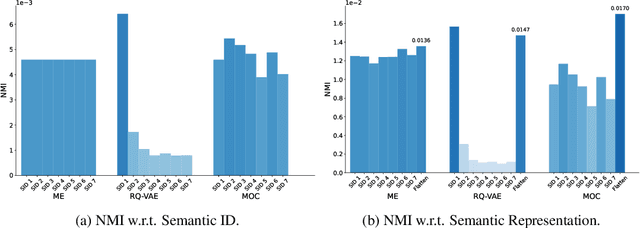

Abstract:With recent advances in large language models (LLMs), there has been emerging numbers of research in developing Semantic IDs based on LLMs to enhance the performance of recommendation systems. However, the dimension of these embeddings needs to match that of the ID embedding in recommendation, which is usually much smaller than the original length. Such dimension compression results in inevitable losses in discriminability and dimension robustness of the LLM embeddings, which motivates us to scale up the semantic representation. In this paper, we propose Mixture-of-Codes, which first constructs multiple independent codebooks for LLM representation in the indexing stage, and then utilizes the Semantic Representation along with a fusion module for the downstream recommendation stage. Extensive analysis and experiments demonstrate that our method achieves superior discriminability and dimension robustness scalability, leading to the best scale-up performance in recommendations.
ReFIR: Grounding Large Restoration Models with Retrieval Augmentation
Oct 08, 2024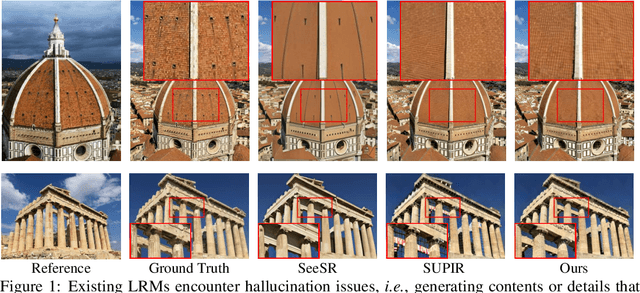
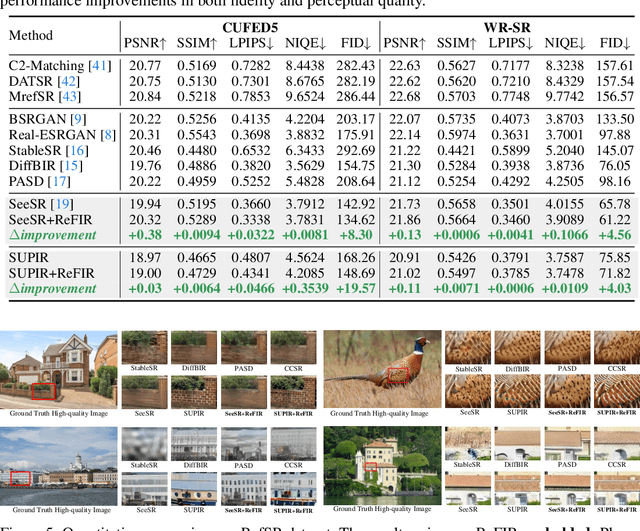


Abstract:Recent advances in diffusion-based Large Restoration Models (LRMs) have significantly improved photo-realistic image restoration by leveraging the internal knowledge embedded within model weights. However, existing LRMs often suffer from the hallucination dilemma, i.e., producing incorrect contents or textures when dealing with severe degradations, due to their heavy reliance on limited internal knowledge. In this paper, we propose an orthogonal solution called the Retrieval-augmented Framework for Image Restoration (ReFIR), which incorporates retrieved images as external knowledge to extend the knowledge boundary of existing LRMs in generating details faithful to the original scene. Specifically, we first introduce the nearest neighbor lookup to retrieve content-relevant high-quality images as reference, after which we propose the cross-image injection to modify existing LRMs to utilize high-quality textures from retrieved images. Thanks to the additional external knowledge, our ReFIR can well handle the hallucination challenge and facilitate faithfully results. Extensive experiments demonstrate that ReFIR can achieve not only high-fidelity but also realistic restoration results. Importantly, our ReFIR requires no training and is adaptable to various LRMs.
Attribution Analysis Meets Model Editing: Advancing Knowledge Correction in Vision Language Models with VisEdit
Aug 19, 2024



Abstract:Model editing aims to correct outdated or erroneous knowledge in large models without costly retraining. Recent research discovered that the mid-layer representation of the subject's final token in a prompt has a strong influence on factual predictions, and developed Large Language Model (LLM) editing techniques based on this observation. However, for Vision-LLMs (VLLMs), how visual representations impact the predictions from a decoder-only language model remains largely unexplored. To the best of our knowledge, model editing for VLLMs has not been extensively studied in the literature. In this work, we employ the contribution allocation and noise perturbation methods to measure the contributions of visual representations for token predictions. Our attribution analysis shows that visual representations in mid-to-later layers that are highly relevant to the prompt contribute significantly to predictions. Based on these insights, we propose VisEdit, a novel model editor for VLLMs that effectively corrects knowledge by editing intermediate visual representations in regions important to the edit prompt. We evaluated VisEdit using multiple VLLM backbones and public VLLM editing benchmark datasets. The results show the superiority of VisEdit over the strong baselines adapted from existing state-of-the-art editors for LLMs.
 Add to Chrome
Add to Chrome Add to Firefox
Add to Firefox Add to Edge
Add to Edge